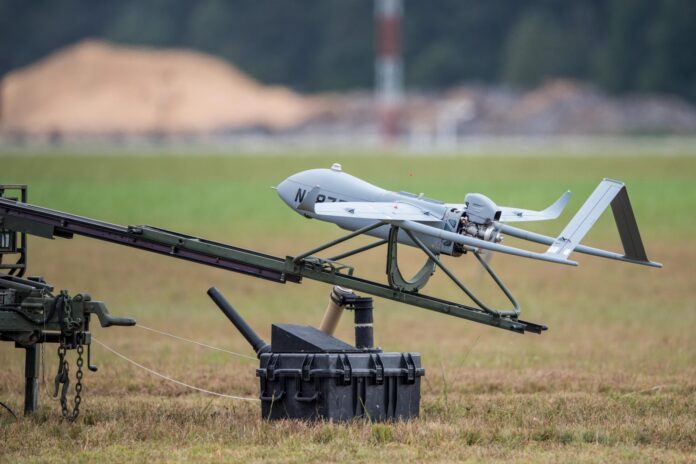The communications link connecting a drone to its pilot is what allows them to be physically separated from each other. It transmits the pilot’s instructions to the drone and relays data about the aircraft’s position, speed, performance, and other safety-critical information back to the pilot. The farther the drone flies, the more important that link becomes — and the harder it is to maintain. By the time it flies beyond the pilot’s visual line of sight — an industry milestone that may ultimately determine drones’ commercial viability — it’s vital.
Developing technology that can handle those long-distance links is a fundamental prerequisite for flights beyond the visual line of sight, and it isn’t trivial.
In collaboration with NASA, Collins Aerospace, and Textron Systems, the Virginia Tech Mid-Atlantic Aviation Partnership (MAAP) conducted a series of radio tests that advanced a major piece of the effort to facilitate long-distance drone communications: Access to licensed wireless spectrum allocated for aviation use.
“These tests were the culmination of more than a decade of international development,” said Mark Blanks, the director of MAAP, an FAA-approved drone test site. “They represent a tremendous effort by the industry to identify available spectrum and develop radio performance standards, and years of technology development and testing by NASA and Collins.”
Today, most communications between drone and pilot rely on unlicensed portions of the wireless spectrum. These frequencies are open to any user, but they’re crowded and subject to interference. Unlicensed spectrum is also limited to low-powered signals that have a relatively short range — typically a few miles. As long as other technical and regulatory challenges have hemmed in most drone operations to a tight radius around the operator, the range of communications signals hadn’t been a limiting factor.
But as technology advances and more companies clear regulatory hurdles, longer flights are edging closer to feasibility. These operations will require higher-powered signals that can travel tens or hundreds of miles and are protected from interference by other users. One promising option for enabling links like this is direct communication between the pilot and the drone on licensed radio spectrum dedicated to aviation.
Required for nearly all manned aviation applications, licensed spectrum allocates reserved slices of bandwidth for specific purposes, so it can accommodate stronger signals and is protected from interference. But drones, with still-evolving communications technology, have had limited ability to access it.
After several years of lobbying, sections of licensed spectrum were allocated for drone use in 2007 and 2012. Next, the industry needed to develop technology and performance requirements that could support drone communications on these regions of the spectrum. And gaining approval from federal agencies to access this spectrum permanently would require extensive testing to characterize the effectiveness and reliability of this new technology and demonstrate that it wouldn’t interfere with other spectrum users.
MAAP’s tests were among the first to assess these parameters utilizing a radio on board a drone in flight. The radio was a prototype from Collins Aerospace designed to evaluate performance standards released in 2016 for radios using licensed spectrum for drone communications. It was mounted on Textron Systems’ Aerosonde aircraft, whose long range made it a good candidate to test the radio’s ability to maintain a link at extended distance.
“This flight series was the final set of tests in a larger test effort conducted by MAAP for NASA’s UAS Integration in the NAS project, with elements contributing to both ground based detect and avoid and command and control systems development,” said Clint St. John, chief engineer for the NASA project. “The communications flight testing conducted by MAAP added to the extensive NASA and Collins collaborative development and flight test efforts and was unique in that it was one of the first efforts to integrate and flight test the radio on a mid-sized UAS, inclusive of the physical integration of the radio and required peripherals on the UAS, and the integration of the required control message set into the transmission format of the radio into the system that was evaluated.”
With an experimental license that gave them access to the 5030 – 5091 MHz band set aside in 2012, the team ran the aircraft through a series of maneuvers designed to test the radio’s performance under realistic conditions.
“Launch and recovery, evasive flight maneuvers, emergency high bank maneuvers — anything you might feasibly see in flight, we wanted to try to duplicate,” said Robert Briggs, the MAAP engineer who led the tests. They also evaluated how the radio’s performance was affected by distance and proximity to rugged terrain at the remote Arizona test range where the experiments took place.
“We tested the radio in areas where we were one hundred percent sure we were going to lose link because of the terrain,” Briggs said. “Where we saw degraded performance was where we expected to.”
The Collins Aerospace CNPC radio performed strongly out to the maximum range the team tested, pointing to a viable path forward for drone communications on licensed spectrum. The experiments will also help inform the development of industry standards for this technology, and ongoing research to design robust radio links that are compatible with existing and future aircraft.
“We’re getting to a point where we’re actually gathering the data that’s going to inform industry efforts to build safety critical data links for UAS that meet the needs of end users like Textron,” said MAAP chief engineer John Coggin. “We’re beginning to remove the unknowns and validate the assumptions that will result in solid standards and service rules for this piece of spectrum. Just doing these flight tests is a milestone for the industry.”
Aerosonde is a registered trademark of Textron Systems Corporation.

